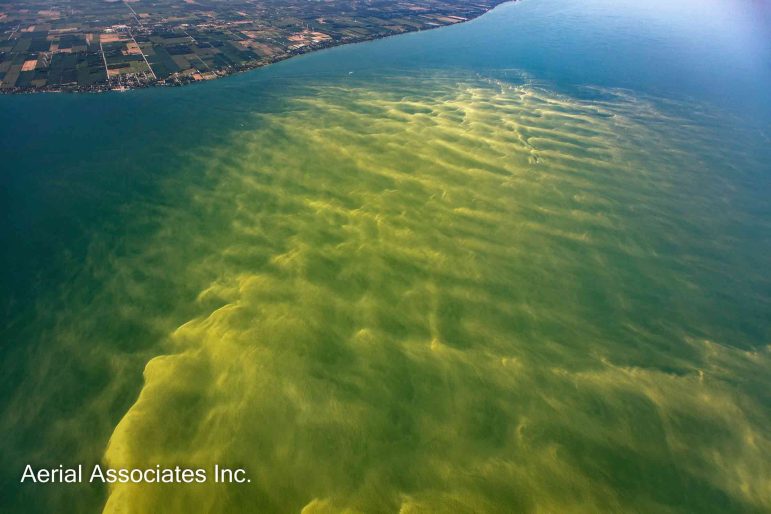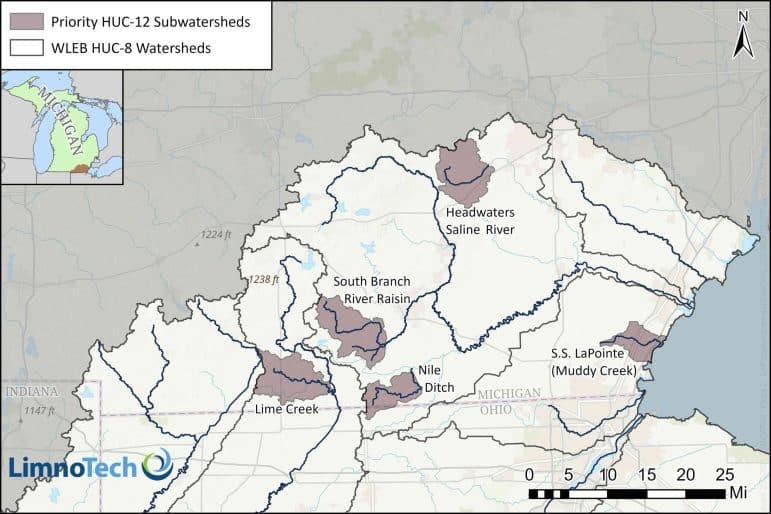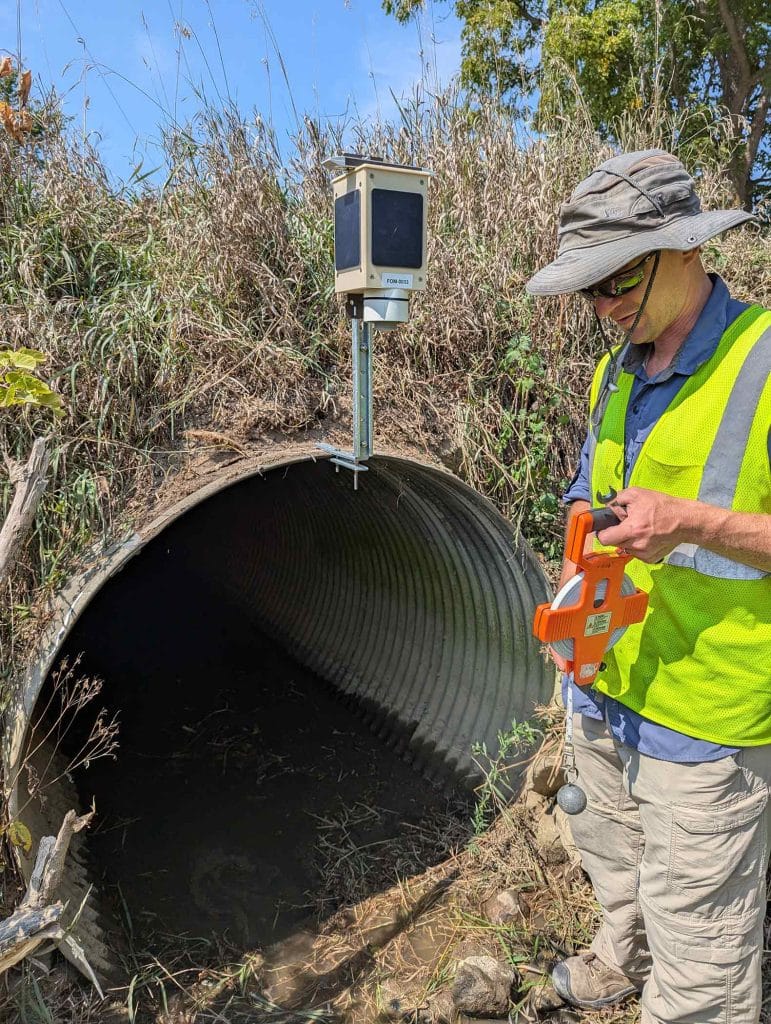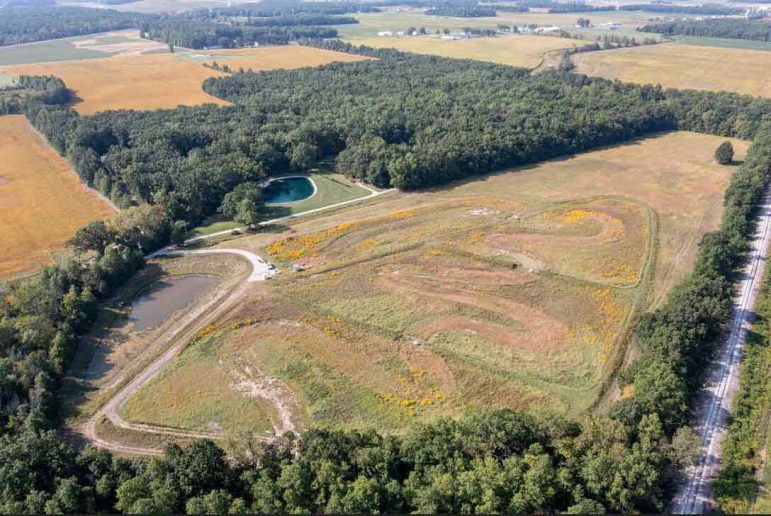
Answering the Challenge of Harmful Algal Blooms in the Western Lake Erie Basin
LimnoTech has been at the forefront of research, policy development, and implementation of mitigation strategies to reduce the impacts of HABs in the Western Lake Erie Basin (WLEB).
By Derek Schlea, Principal & Senior Ecological Engineer (Ann Arbor, MI) and Ed Verhamme, Principal & Senior Environmental Engineer (Ann Arbor, MI), President of Freeboard Technology (Cleveland, Ohio)
April 17, 2025
The Western Lake Erie Basin (WLEB) Challenge
Excess nutrient pollution has led to the re-emergence of Harmful Algal Blooms (HABs) as a major concern in the Western Lake Erie Basin (WLEB). The watershed for this basin covers more than seven million acres, encompassing most of northwest Ohio and portions of northeast Indiana and southeast Michigan, and is one of the most significant networks of inland rivers and streams in the United States. Over the last two decades, HABs of unprecedented severity and toxicity have caused ecosystem, economic, and human health impacts. LimnoTech has been at the forefront of research, policy development, and implementation of mitigation strategies to reduce these harmful impacts. A few of these efforts are featured below.
Planning: Adaptive Management Planning
Through contracting arrangements with Michigan’s Department of Environment, Great Lakes, and Energy (EGLE), LimnoTech supported the State’s Lake Erie Domestic Action Plan (DAP) team in developing an Adaptive Management Plan to reduce phosphorus loading into Lake Erie. We are supporting the state quality of life agencies to complete the five-year update to the DAP. Our contributions have included analysis of water quality monitoring data to determine trends in phosphorus loading, revising baseline and load reduction targets based on new information, investigating load contributions from point and nonpoint sources, and communicating milestones and findings during semi-annual WLEB Advisory Group meetings.
Policy: Cost-to-Comply
LimnoTech provided technical support to the Alliance for the Great Lakes to quantify the cost to meet water quality goals for the WLEB through increases in agricultural conservation practice adoption for addressing nonpoint source nutrient runoff. After completing an assessment for the entire Michigan and Ohio WLEB drainage areas, we supported strategic planning for Michigan’s five priority WLEB subwatersheds.

The work involved leveraging recent data generated by the State to develop field prioritization maps to help target agricultural conservation practices placement, estimating baseline and conservation adoption scenario nutrient load estimates, and quantifying implementation costs. A summary report by LimnoTech and the Alliance for the Great Lakes details the work done for Michigan’s priority subwatersheds.
Watersheds: Monitoring
LimnoTech, working with its subsidiary Freeboard Technology, is participating in a first-of-its-kind watershed monitoring program on five priority subwatersheds in the Michigan portion of the WLEB watershed. These watersheds are hotspots of excess nutrient runoff. A new fifty (50) station monitoring network will track movements of water, sediment, and nutrients at a high temporal and spatial resolution through 2029.

The project is funded by the Michigan Department of Agriculture and Rural Development (MDARD) and the Erb Family Foundation. LimnoTech worked cooperatively with the Alliance for the Great Lakes and Michigan State University’s Institute of Water Research (MSU-IWR) to conceive of the project and ambitiously implement this massive increase in monitoring in rural watersheds dominated by agriculture. The outcomes of this project will help MDARD prioritize the implementation of nutrient mitigation strategies and track progress toward reduction goals. A webinar about the project (WLEB 2025 Winter Webinar Series: High-Density Water Quality Monitoring, February 2025) discusses the work. The Alliance for Great Lakes also maintains a project page with relevant press releases and data reports here: https://greatlakes.org/wlebmonitoring/.
Additional details on this project can be found in the following articles:
- MDARD Partners with Alliance for the Great Lakes, MSU Institute of Water Research, and LimnoTech to Deploy Nearly $5 Million in Water Quality Monitoring in the Western Lake Erie Basin (MDARD)
- Monitoring Milestone in Fight Against Lake Erie Pollution
- MI and OH: Different strategies to reduce Lake Erie nutrient pollution
- Pushing Lake Science Upstream: Agriculture and Algal Blooms at Lake Erie
Watersheds: Modeling
LimnoTech supported various organizations spanning a ten-year period in the WLEB using the Soil and Water Assessment Tool (SWAT). The efforts involved collaboration with a diverse mix of institutions and subject matter experts, including the federal government, universities, NGOs, and agricultural industry partners. Our work investigated the potential benefits of agriculture conservation strategies and helped guide implementation efforts. We also collaborated with a multidisciplinary team to develop a “triple bottom line” assessment of the benefits of the 4R Nutrient Stewardship Certification Program led by The Nature Conservancy (TNC), including evaluations of ecological, economic, and social benefits. LimnoTech collaborated with its partners to publish several peer-reviewed papers on these Maumee River watershed studies, including in the journal Water Research and the Journal of Great Lakes Research.
Implementation: Wetlands Restoration
As part of the Great Lakes Restoration Initiative (GLRI), the US Army Corps of Engineers (USACE) – Buffalo District, the US Army Engineer Research and Development Center (ERDC), and LimnoTech partnered with the City of Defiance, Ohio, to design and construct a 10-acre demonstration wetland to serve as a prototype or model for optimizing phosphorus retention and nonpoint source phosphorus load reduction from agricultural landscapes.
The wetland demonstration site is being used to identify characteristics that promote phosphorus retention, identify limitations of the technology, and improve water quality in tributaries to the Maumee River. Field-scale research at the demonstration site is ongoing. It includes weather monitoring and an evaluation of the hydraulics, biogeochemistry, and water quality parameters associated with optimal phosphorus removal in constructed wetlands. You can watch a video summary of the project here: Wetlands Technology for Controlling Sediment and Nutrient Impacts on Aquatic Ecosystems.

Nature’s complexity is its strength. As a wetland evolves, its plants adapt to facilitate growth, and its microbial communities and biogeochemical cycles shift to process new inputs. Similarly, river cross-sections self-adjust to changes in their hydrologic forces. In urban settings, we have to find ways to benefit from the dynamism and adaptivity of natural systems while honoring the things we can’t compromise on – functional roadways, reliable power, and homes that are safe from flooding. When we design our urban infrastructure to support nature’s complexity, natural functions assert themselves to support a new urban ecology that thrives on its own and builds resilience. Our job, then, becomes less about engineering and more about caretaking.
In Michigan, LimnoTech is supporting the monitoring, design, and engineering for the construction of a 300+ acre wetland that will reduce the downstream impacts of excess nutrient pollution. The project site had previously been a vibrant wetland area prior to the 1920s and will be home to a new state recreation and game area that will offer flow-through wetlands and habitat for waterfowl and other wildlife.
Ducks Unlimited, in partnership with the Michigan Department of Natural Resources (DNR) and other state agencies, involved LimnoTech early in the project to assist with site selection and to better integrate nutrient reduction strategies on the property to ensure maximum nutrient retention. The project demonstrates the efficacy of restoring wetlands on marginally productive farmlands that are scalable and easy to monitor water quality improvements. Projects like this one illustrate the collaboration needed amongst landowners, state regulators, NGOs that can act as a local catalyst, and scientists and engineers, like those at LimnoTech. The project was featured in a webinar, “Wetland Restoration In Michigan.”
Looking Ahead to What’s Next
Working with our dedicated clients, partners, collaborators, and stakeholders, we believe we can find and implement impactful solutions to HABs in the WLEB. We all want thriving ecosystems, protections for human health, and economic prosperity.
Coming up this summer, the “State of the Western Lake Erie Basin Conference,” hosted by EGLE, will be taking place on June 26 in Adrian, Michigan. The conference brings together decision-makers, researchers, farmers, and community members to discuss efforts to meet nutrient reduction goals and track progress in Michigan’s watersheds that drain into the WLEB.
Tom Zimnicki, the Alliance for Great Lakes Agricultural and Restoration Policy Director, and Ed Verhamme will share an update on MDARD’s five-year collaborative, enhanced water quality monitoring effort of priority subwatersheds in the WLEB. Derek Schlea and John Bratton will also be attending the conference, providing support to the State by facilitating discussions and synthesizing key feedback from event attendees.
Reach out to Derek Schlea at dschlea@limno.com or Ed Verhamme at everhamme@limno.com if you have any questions about LimnoTech’s work in the WLEB. You can also learn more about LimnoTech’s work by checking out our Harmful Algal Blooms, Water Quality Monitoring, Water Resource Modeling, Waterway & Ecosystem Restoration, and Sustainable Agriculture pages. You can learn more about advanced environmental monitoring, sensing, and technology at Freeboard Technology’s website.
Derek Schlea, PE, is a Principal and Senior Ecological Engineer with expertise in watershed planning, water quality, wetlands and other nature-based solutions, and agricultural conservation practices. His current roles at LimnoTech include executing technical work, managing projects, supporting employee ownership initiatives, and leading the company’s agricultural conservation practice area. During his career, Derek’s project experience has included developing and applying watershed and surface water quality models, completing watershed management plans and assessments, green infrastructure design, water quality performance monitoring, and decision support tool development.
Ed Verhamme is a Principal and Senior Engineer at LimnoTech and the president of Freeboard Technology, a new water technology start-up he co-founded as a subsidiary of LimnoTech. Ed is well known for his work across the Great Lakes region over the last twenty years to design, build, and maintain the next-generation sensing network that supports hundreds of thousands of boaters, key water managers, and critical infrastructure owners. In 2021, Ed served as the International Association for Great Lakes Research president and supports ongoing work to build robust public-private partnerships to tackle tough social justice and environmental issues. and community-engaged project development to enhance the resilience of Great Lakes coastal cities to climate change-related challenges. Michelle leads the biological sciences, ecosystem services, and fisheries service practice areas at LimnoTech and has experience working in transdisciplinary teams, including academic, non-profit, municipal, and federal groups.




